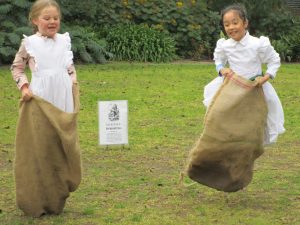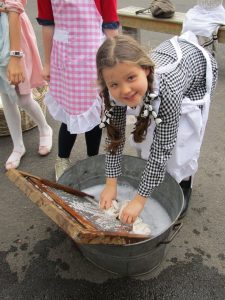Understanding the Australian Curriculum Achievement Standards

In designing the Australian Curriculum, the writers for each curriculum/subject area included: a year level description, outlining the key standards within each subject area; the content to be taught at each year level; and the standard to which most students across Australia in the year level should achieve. These standards are the ‘Achievement Standards’.
Below is the ACARA (Australian Curriculum Assessment and Reporting Authority) Achievement Standard for Year 4 Mathematics.
Understanding:
By the end of Year 4, students choose appropriate strategies for calculations involving multiplication and division. They recognise common equivalent fractions in familiar contexts and make connections between fraction and decimal notations up to two decimal places. Students solve simple purchasing problems. They identify and explain strategies for finding unknown quantities in number sentences. They describe number patterns resulting from multiplication. Students compare areas of regular and irregular shapes using informal units. They solve problems involving time duration. They interpret information contained in maps. Students identify dependent and independent events. They describe different methods for data collection and representation, and evaluate their effectiveness.
Skills:
Students use the properties of odd and even numbers. They recall multiplication facts to 10 x 10 and related division facts. Students locate familiar fractions on a number line. They continue number sequences involving multiples of single digit numbers. Students use scaled instruments to measure temperatures, lengths, shapes and objects. They convert between units of time. Students create symmetrical shapes and patterns. They classify angles in relation to a right angle. Students list the probabilities of everyday events. They construct data displays from given or collected data.
“The achievement standards for each learning area are organised as Understanding and Skills and describe a broad sequence of expected learning across Prep to Year 10. They emphasise the depth of conceptual understanding, the sophistication of skills and the ability to apply essential knowledge.” – (ACARA 2018).
The Achievement Standards set the standard for reporting for all students in a year level across Australia, ensuring a ‘Demonstrating’ for Year 4 in Melbourne is the same standard as Year 4 anywhere else in Australia.
As you can see from the statements within the Achievement Standards above, there is a shift away from recall of information to students being able to demonstrate their knowledge and skills against this standard. The verbs highlighted in the Achievement Standard describe the standard of ‘Understanding’ and ‘Skills’ for Year 4 students by the end of the year, and are more cognitively sophisticated than in previous curriculums, as evidenced by verbs such as: explain, describe, compare, locate, classify, measure, interpret and solve.
This year, the Junior School reports for Barbreck girls showed a five point scale: Emerging, Developing, Demonstrating, Advancing and Extending. The ‘Demonstrating’ level aligns to the Achievement Standard. The renaming of the reporting scale is now more reflective of the learning journey undertaken by the girls as they progress in their learning throughout the year against the scale.
|
Extending
|
Beyond the Standard | Working with depth beyond the Achievement Standard. |
|
Advancing
|
Beyond the Standard | Working beyond the Achievement Standard. |
|
Demonstrating Expected level of achievement for Year 4 by the end of the year. |
Demonstrating the Achievement Standard. | |
| Developing | Developing towards the Achievement Standard. | |
| Emerging | Emerging into the Achievement Standard. | |
When looking at your daughter’s report, the expected standard for most students in her year level in Australia is a ‘Demonstrating’. To achieve higher, a student must show they are working outside of and above the standard. They would be showing independent choice of skill and be able to apply in new or unfamiliar contexts and to greater depth, often outside the teaching context.
For example:
| Extending | Identify and describe techniques for generating other equivalent fractions (e.g. say that the numerator and denominator of any fraction can be multiplied (or divided) by the same number to create equivalent fractions). |
| Advancing | Explain why fractions with different denominators can be termed as equivalent (e.g. use a number line to demonstrate that fractions such as 6⁄8 and 3⁄4 occur as the same point on the line and therefore have the same value). |
| Demonstrating | They recognise common equivalent fractions in familiar contexts and make connections between fraction and decimal notations up to two decimal places. |
(Australian Independent Schools Queensland Progression Points, 2015)
As you can see from the example above, the standards of Advancing and Extending are beyond and outside of the ‘Demonstrating’ standard.
The Semester 1 report indicates the level at which a student is performing against mid-year indicators for being ‘on track’ towards ‘Demonstrating’ by the end of the year.
Ms Karen McArdle, Head of Junior School
Parliament and Civics Education Rebate Program (PACER) Funding
The Year 6 students recently participated in an educational tour of Canberra. Students had many opportunities to participate in a variety of educational programs with a focus on Australia’s history, culture, heritage and democracy.
The Australian Government recognises the importance of all young Australians being able to visit the national capital as part of their Civics and Citizenship education. To assist families in meeting the cost of the excursion, the Australian Government contributed some funding towards costs under the PACER program. The rebate of $30.00 per student is paid directly to St Catherine’s upon completion of the excursion.
Years 1 and 2 Students Visit Como House
As part of the History focus on how daily family life is the same or different to previous generations, students in Years 1 and 2 visited Como House on Friday 2 August. Although the weather did not look promising, the rain held out and the day was enjoyed by all.
The students quickly immersed themselves into role-play, which gave them a unique opportunity to step into the shoes of people who lived and worked at Como House. The hands-on activities and engaging experiences ranged from playing children’s games from the past such as jacks, croquet and sack races, to pretending to be servants to the Armytage family who lived in Como House.

Genevieve Campbell (Year 2) and Miya Fei (Year 2) enjoy playing children’s games from the past at Como House.
The students gained a better understanding on how life for some was not easy and there were many comparisons made to today’s way of living.
Mrs Loretta Iacuone, Year 2 Teacher
Year 1 Student Reflections from Como House Excursion
On Friday 2 August, Years 1 and 2 travelled by bus to Como House. We played olden day games. We did skipping and played What’s the Time Mr Wolf? I went into the ballroom and we did a special dance. We saw all the rooms. – Salina Zhang.
We went on a mansion tour. We went to Mr and Mrs Armytage’s bedroom. We went on a treasure hunt in the garden to find out the mystery of the broken doll. We had to find 14 clues. – Jiayi (Kitty) Huang.
First, my group went to play some olden day games. Here are some of the games we played: croquet, hot potato, What’s the Time Mr Wolf?, sack races, and egg and spoon race. – Samara Grinsell.
I did the servant training last. The servants had to learn the rings of the 14 bells to know which room to go to. – Amelie Lane.



